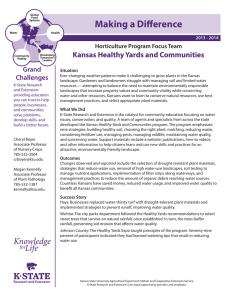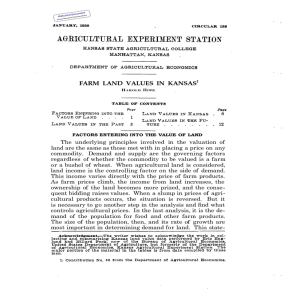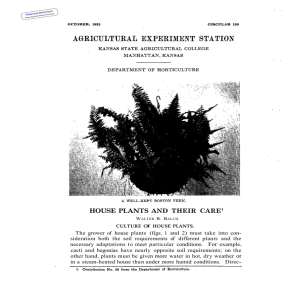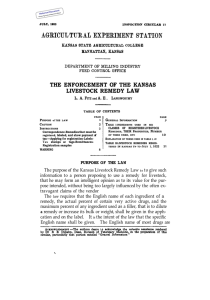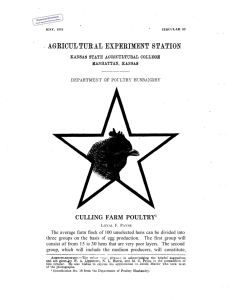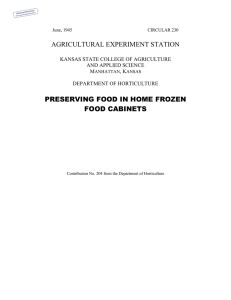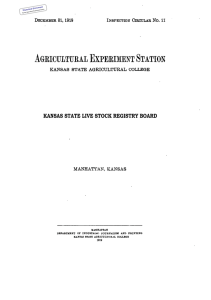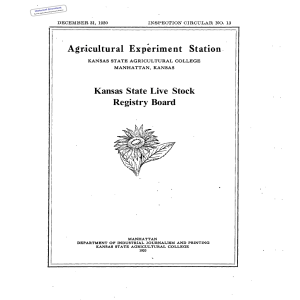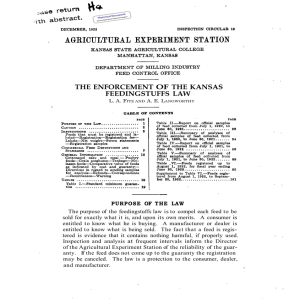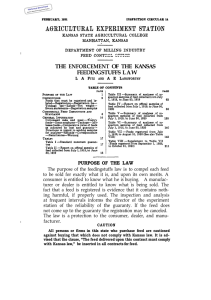Winter Irrigation for Western Kansas Historical Document Kansas Agricultural Experiment Station
advertisement
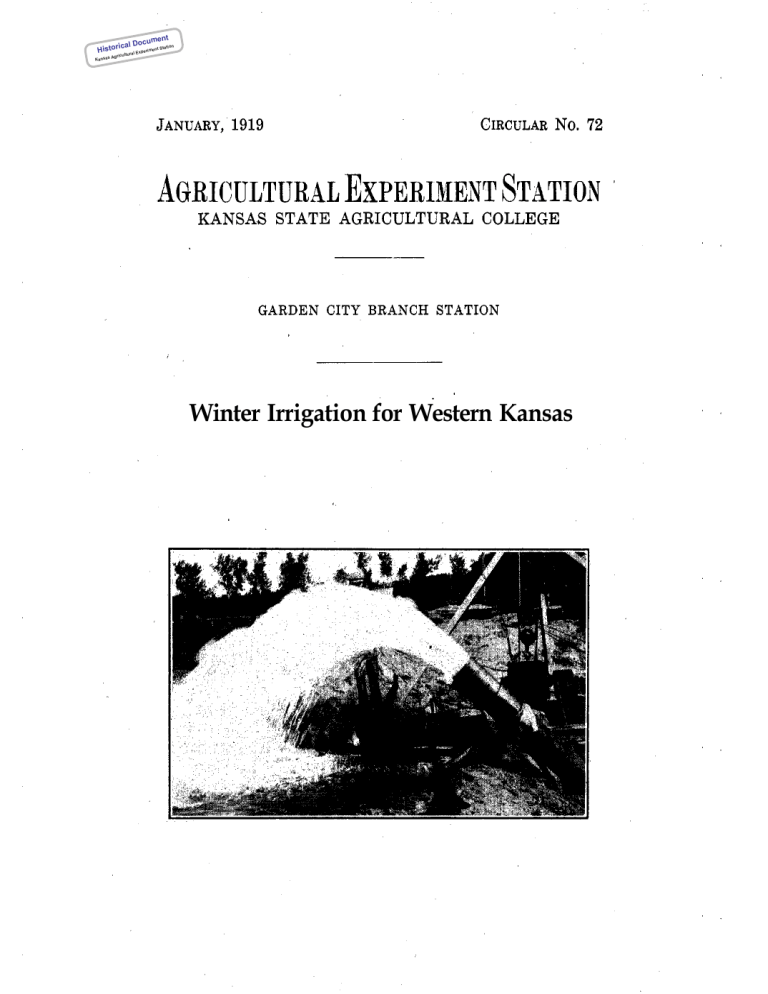
t cumen n cal Do tio Histori ural Experiment Sta Kansas Agricult Winter Irrigation for Western Kansas t cumen n cal Do tio Histori ural Experiment Sta Kansas Agricult WINTER IRRIGATION FOR WESTERN KANSAS GEORGE S. KNAPP Superintendent o f the Garden City Branch Station During the past three or four years there has been a decided increase in the interest in irrigation in western Kansas. The severe drouths which have been experienced during this period have had much to do with this increased interest. The successful development of irrigation agriculture in western Kansas involves a large number of different factors. One of the important factors relates to labor, the supply of which ordinarily is short, particularly during the growing season. For several years experiments relating to problems of irrigation agriculture in western Kansas have been in progress a t the Garden City Branch Station. One of these experiments has had to do with determining the feasibility of winter irrigation; that is, the artificial application of water to the soil between harvest time in the fall and planting time the following spring. This circular discusses some of the more important features of the results secured and emphasizes the desirability of winter irrigation in western Kansas with particular reference to labor economy. ADVANTAGES OF WINTER IRRIGATION Wherever winter irrigation can be successfully carried on in western Kansas, it is to be recommended. It offers many advantages. It utilizes labor during the winter months when labor is the most plentiful and requires correspondingly less labor during the busier months of the year. It allows the farmer that hires a great deal of labor to do a larger portion of the farm work during the winter months when labor is cheapest. Other noteworthy advantages of winter irrigation are as follows: 1. Water applied during the winter months has more time to penetrate into the soil, and consequently penetrates to a greater depth than if applied during the growing season. This serves to deepen the zone in which the plants can feed. Where water is applied in amounts of from 4 to 6 inches during the t cumen n cal Do tio Histori ural Experiment Sta Kansas Agricult growing season it seldom has time to penetrate more than from 1 to 3 feet before the hot sun, wind, and the rapidly growing crop have taken out enough to arrest its downward movement. Thus the subsoil is kept too dry for root development, and the roots are compelled to spread out near the surface instead of being allowed to grow downward. The feeding zone is thus limited to the first few feet of soil, which is subjected to high temperatures during the hot summer months, causing the plants to suffer. A loam soil, such as that in western Kansas, will hold from 2 to 3 inches of water per foot of depth. That being true, an application of 15 inches of water will penetrate it from 5 to 8 feet deep. The roots of nearly all farm crops will go to that depth if moisture conditions are favorable. The roots, therefore, may have nearly three times the feeding zone they would have if this amount of water was to be applied in three applications, aggregating 15 inches, during the growing season. This is of considerable importance if large yields are to be secured. 2. Much more plant food is liberated where the water has had time to saturatethe soil thoroughly. This is due not only to the fact that the feeding zone is deepened, but also to the fact that plant food is liberated more rapidly from soil that is fairly moist. 3. Thawing and freezing greatly improve the texture of the soil. The freezing process expands the soil and breaks up the soil particles. Thawing then leaves the soil in a loosened condition. Dry soil i s not affected by the action of frost to the extent that wet soil is; therefore soil that has been irrigated in the fall and is wet through the winter will be in a better physical condition in the spring than dry soil. 4. Often water applied to a growing crop, especially one suffering for water, will produce excessive vegetative growth when the crop should be making grain. Or it may cause the plants to start a new growth and greatly delay maturing. If the crop were. able to extend its root system for food and moisture, as might be the case on winter-irrigated land, a more normal growth would be produced and earlier maturity result. Thus from the standpoint ofcrop production as well as from that of saving summer labor it is desirable that winter irrigation be practiced in western Kansas wherever possible. t cumen n cal Do tio Histori ural Experiment Sta Kansas Agricult RESULTS OF EXPERIMENTS Experiments at the Garden City Branch Experiment Station covering a period of five years have shown that sufficient water can be stored in the soil by winter irrigation alone to produce good crops of corn, kafir, milo and certain other row crops. The soil on which these experiments were made is a deep silt loam, representative of most of the upland in the western part of the state. Good yields have been obtained each year with all crops grown on the winter-irrigated land. At the same time, with the exception of the wet season of 1915, unirrigated land produced practically nothing. Table I gives the yields obtained with some of the crops in these experiments in 1916,1917, and 1918. For the 1916 crop, 14 inches of water was applied in December of the preceding year; for the 1917 crop, 14 inches of water was applied in November of the preceding year; and for the 1918 crop, 18 inches of water was applied in the early spring before planting time. None of the crops was irrigated during the growing season. The yields of some of the 1918 winter-irrigated crops compared with yields obtained on unirrigated adjacent land, otherwise under similar conditions, are shown in figures 1, 2, 3, and 4. t cumen n cal Do tio Histori ural Experiment Sta Kansas Agricult t cumen on cal Do Histori ural Experiment Stati Kansas Agricult REQUIREMENTS FOR SUCCESSFUL WINTER IRRIGATION. Soil must be put in proper condition to receive winter irrigation. If not, it is difficult to get it to take at one application the large amount of water required (14 to 18 inches in the experiments at the Garden City station). If a large amount of water is applied to ground in poor condition an uneven irri- t cumen n cal Do tio Histori ural Experiment Sta Kansas Agricult


